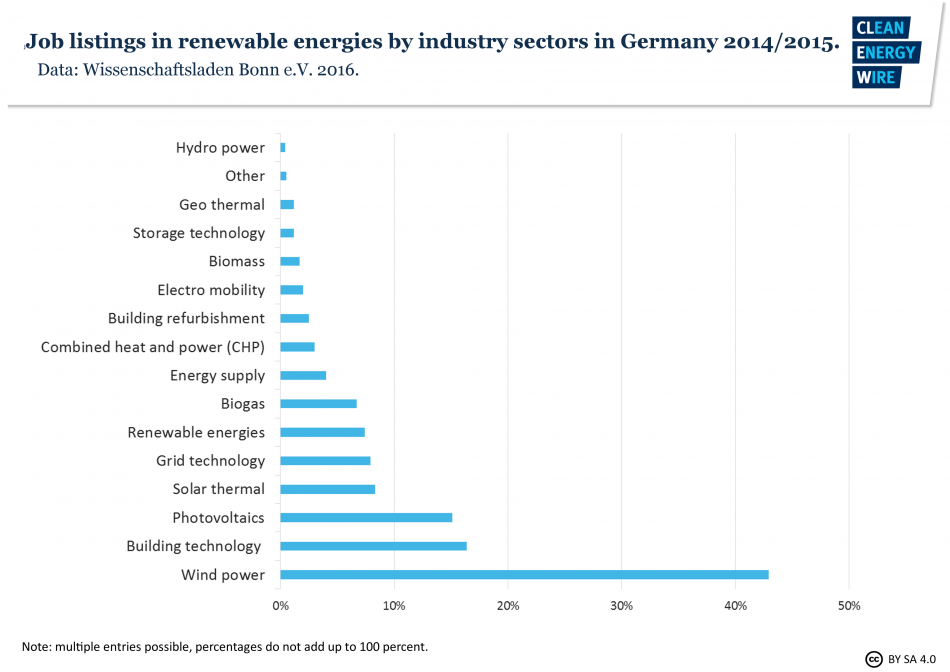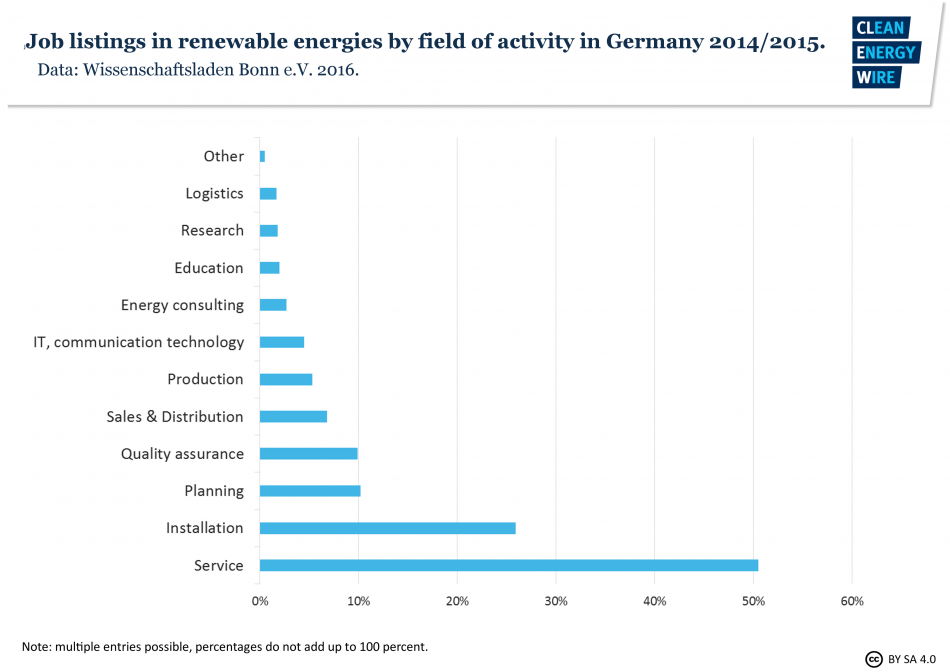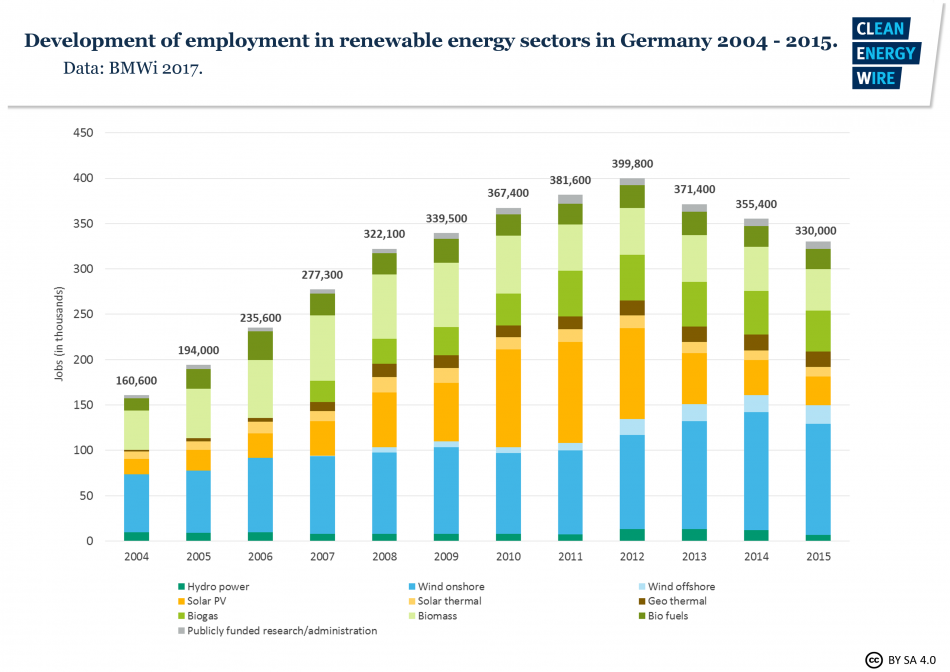Germany’s vaunted vocational training programme strains to meet Energiewende’s demand for skilled workers
“It’s been a huge challenge,” says Philipp Vohrer, director of the Berlin-based Renewable Energies Agency (AEE), referring to Energiewende-related job training. “At first there were no job profiles for the Energiewende. We had lots of electricians, plumbers, service technicians, but they all had to be retrained to work with the new technology. Heating systems professionals, for instance, had to learn about wood pellets and heat pumps. It’s been, and still is, a very dynamic process.”
Indeed, the face of Germany’s labor market will continue to change in the decades ahead with Germany’s share of renewables in the energy mix expected to soar to 60 percent by 2050, a quadrupling of the current volume. The cutting of greenhouse gases by 40 percent by 2020 and up to 95 percent in 2050 (compared to 1990 levels) also implies labor-intensive energy-savings measures in the construction of new buildings, the retrofitting of buildings and factories, and decarbonisation of the transportation and energy generation sectors. [See details on the Vocational Education and Training system in this factsheet]
Thus, primarily through the VET, Germany must train – and retrain – its workforce to handle this complex transition, an endeavor made all the more difficult considering that, until recently, much of the Energiewende had unfolded without an overall master plan, forcing planners to react to shifts in labor market demand in real time. According to a study conducted by the think tank Bonn Science Shope (WILA Bonn) for 2014-15, which analysed job vacancies requiring dual-system vocational training, the demand stems above all from the wind power industry, which accounts for almost half of the new jobs on the market, followed by building services, solar PV, solar thermal, transmission technology, and bioenergy, respectively. Three quarters of the posts were in installation and service (see graphs below).
“The whole energy system in Germany is currently undergoing a rapid digitalisation that will significantly increase the demand for professionals with combined expertise in energy and IT,” says Björn Spiegel, Head of Strategy and Policy of ARGE Netz, a Germany company focusing on renewable energy generation and technology. Although ARGE Netz is currently not short of expertise, Spiegel notes that the energy industry could soon experience staffing problems as have other German industries in the midst of a digital transformation.
The Energiewende’s branches require technical expertise that is currently in such high demand in Germany that labor market shortfalls are commonplace. According to the Cologne Institute for Economic Research (IW) there are 430,000 open positions in skilled professions, most of them in mathematics, computer science, the natural sciences and technology. In the Berufsschule (vocational school) there are thousands of unfilled VET apprenticeships. According to Germany’s Federal Employment Agency (BA), it is above all mechanical, automotive, and electrical engineers, as well as IT professionals, that are in short supply. The Federal Institute for Vocational Education and Training (BIBB) warns that by 2030 the electrical engineering and supply professions – fields vital to the Energiewende – could be short 760,000 skilled workers, the lion’s share in the fields of metallurgy, plant engineering and construction, sheet metal construction, and installation and montage.
Nevertheless, most experts say that Germany’s VET has coped remarkably well with the fluid process so far. “The VET has responded impressively to the demands of the Energiewende,” explains Thomas Vollmer, professor of vocational pedagogy at Hamburg University, who admits he’s a fan of the VET’s unique combination of practical and theoretical training. Over 60 percent of firms in the renewable energy sector offer trainee positions within the VET. One example: the German wind power giant Enercon hosts 320 apprentices at its German sites who are tutored in 20 professions, in fields such as commerce, product design, and diverse industrial trades from metalwork to mechanical engineering.
Integral to the VET, and its process of renewal, is the link between the classroom-based learning and the on-the-job trainings. Even before the BIBB began to incorporate specialized knowledge about new clean-energy technologies into classroom curricula, apprentices were getting hands-on training in Energiewende-related jobs in the branch. “The basic skills, such as the repairing of wind turbines, were already brought into the system before anything was formalised,” says Pia Spangenberger, an analyst at the think tank WILA Bonn. Energiewende branches call on forty different types of skilled professionals trained through the VET, including the likes of electrical engineer, industrial engineer, systems mechanic, automotive mechanic, automotive engineer, and others.
“It’s a flexible, learning system and it’s been able to adjust to these sectors’ needs,” says Vollmer, noting that the VET has been tweaked and altered regularly since 2000 to reflect the new sectors’ demands. The VET enables the private sector to communicate to the BIBB its shifting needs and wishes through Germany’s Chamber of Industry and Commerce (DIHK), which functions as a centralised collection point, gathering input from the private sector. The input has led to regular updates of the curricula within the existing programmes, reflecting the new technologies and their requirements.
This is why, despite the boom in jobs associated with the Energiewende, none of the dual-system VET’s roughly 330 listed professions specifically name renewable energies or climate protection. The formal categories of professions served by the basic VET have not been expanded to include new job descriptions explicitly associated with decarbonisation. A BIBB study conducted from 2013 - 2015 surveyed Energiewende-related industry to determine whether it felt that the branches needed new job titles or whether the existing professions sufficed. The private sector responded that the Berufsschule curricula with regular updates was adequate.
The VET also encompasses an advanced vocational degree - a level of expertise above that of the skilled worker - namely that of “specialist technician,” which requires professional experience and an additional two years of study at a vocational college. In contrast to the Berufsschule, the technical colleges (Fachschulen) have created new professional categories reflecting the Energiewende, such as “environmental technician,” “specialist solar technology,” “solar technician,” “technician in wind energy technology“ and “technician for renewable energies.”
In the aftermath of the Fukushima nuclear meltdown in 2011, the century-old Berufsschule Waldmünchen in Bavaria called to life the Technical College Waldmünchen: Vocational College for Environmental Technology and Renewable Energies, which offers new advanced courses specialising in Energiewende-related fields, including one for the training of environmental technicians. Its trainee-students continue with classroom study and apprentice at local Bavarian firms doing business in hydropower, PV and wind power, cogeneration, and biogas. Yet, the college admits that after an enthusiastic start the number of environmental technicians-in-training dropped from a high of 20 in 2014 to just eight this year.
Another important component in the process of workforce adaption – though not part of the VET – is advanced specialisation courses (Weiterbilding, Fortbildung). Hundreds of such courses lasting from a week to a year offer advanced training that complements and adds to the qualifications of skilled professionals and technician specialists. Enercon, for example, has its own training department and the Enercon Academy that conduct advanced trainings. General Electric located its ten-million-euro Global Learning Center in Berlin to teach employees and customers, how to run its equipment and learn other new skills. The Stiftung Offshore Windenergie, an industry advocacy group, lists several such advanced course possibilities for dual system graduates, among them wind turbine construction, welder for offshore construction, and service technician for offshore rigs. Upon completion, participants usually receive a certificate but not a new professional title.
Mind the Gap
The labour market gaps and gradual decline in VET participants has the programme searching for explanations – and responses. The problem of shortfalls, says Vollmer, an expert in mechanics and automation, is not the system’s failure. “Fewer and fewer young people are opting for the VET track,” he says. “They’re going for some kind of higher degree at polytechnic schools and universities.”
Markus Janser of Germany’s Institute for Employment Research (IAB) argues that renewable energy firms tend to take more highly qualified employees (about 19 percent) than do non-renewable energy firms (about 10 percent). Consequently, renewable-energy firms employ fewer employees with VET credentials (about 45 percent) compared to non-renewable-energy firms (about 52 percent). “The degrees in higher education are attractive for many reasons,” he says, citing higher pay in the workforce, prestige, international orientation, wider course options, better possibilities for career advancement, and the opportunity to enter research. Other explanations include the decline in solar PV panel manufacturing in Germany and the country’s demographic slump.
"What we need in order to avoid massive bottlenecks and labour gaps,” says BIBB President Friedrich Hubert Esser, “is a significant increase in the appreciation of dual vocational training in our society and not a one-sided increase in the rate of university graduates. This requires that work in small businesses be an attractive alternative to employment in large companies or public service."
Yet Spangenberger of Wissenschaftsladen Bonn says that the VET “is working but could work better.” With the objective of simplifying entry into the renewable energies field, she proposes that the dual-system VET include professions specific to the renewable energy and climate sectors. “Young people should have the opportunity to start out on the path of renewable energies right from the beginning,” she says. “As it is now, they have to figure it out for themselves, for example by looking at job announcements in the renewable energy sector to determine which dual vocational training might fit to get those jobs. It would be easier and more attractive if the occupational pathway toward the renewable energy sector was clearer. It would promote the branch.”
In particular, she says, young women – a small minority in technical fields – could find their way into an Energiewende-related profession. Spangenberger says that “young people are motivated by the idea of working for the environment and contributing to society. Sustainability can foster young peoples’ interest in a technology career,” she says.




